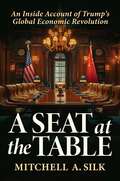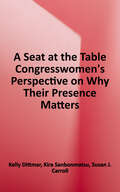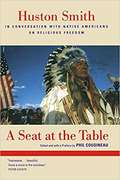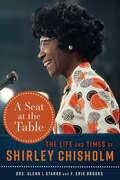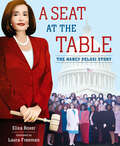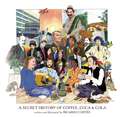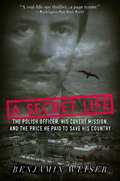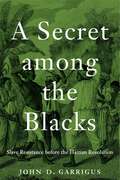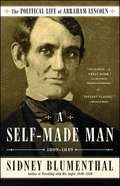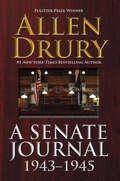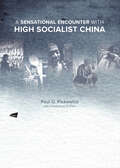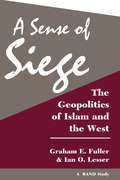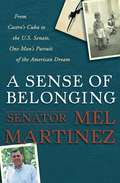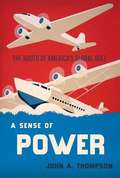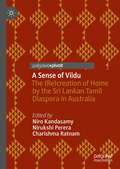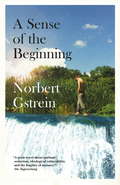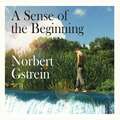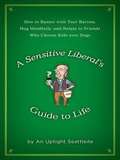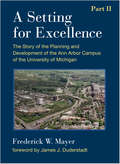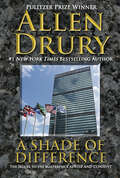- Table View
- List View
A Seat at the Table: An Inside Account of Trump's Global Economic Revolution
by Mitchell A. Silk&“From the trade negotiations with China to implementing the CARES Act during the pandemic, Mitchell Silk played a critical role during some of the most challenging economic moments in recent history.&” —Steven T. Mnuchin, 77th Secretary of the US Treasury From his earliest beginnings as a dishwasher in a Chinese restaurant to his work in international law and finance, Mitchell Silk&’s story illustrates how perseverance and divine providence led him to become the first Hassidic Jew ever confirmed by the Senate for a position in the US Federal government and a consequential leader in Trump&’s Treasury.Mitchell Silk served as assistant secretary for International Markets at the US Department of the Treasury, and was the first Hassidic Jew to ever serve in a presidentially-nominated and Senate-confirmed role. His inspirational story is about the providence, perseverance, and personal touch it takes to bring about positive change in the world. During his thirty-year legal career, Mitchell developed deep expertise in banking, finance, energy, and infrastructure. He advised on many large cross-border capital-intensive landmark energy and infrastructure projects all over the world. As assistant secretary in the Treasury, Mitchell played a senior role in the trade negotiations with China, designed and implemented both the landmark América Crecé initiative and the Trump 45 Administration signature program in the Western Hemisphere that spurred infrastructure growth through private capital solutions in Latin America and beyond, and spearheaded the $94 billion program that saved the airline industry during COVID. While personal touch and faith in positive outcomes are not often considered de rigueur when it comes to assembling a top-shelf toolkit for international economic policy and diplomacy, they were an essential part of Mitchell&’s experience. You will see that good intentions, kindness, and understanding—not to mention a delicious meal shared between friends and enemies—have a unique ability to bridge cultural differences and achieve peace and prosperity.
A Seat at the Table: Congresswomen's Perspectives on Why Their Presence Matters
by Kira Sanbonmatsu Susan J. Carroll Kelly DittmarThe presence of women in Congress is at an all-time high—approximately one of every five members is female—and record numbers of women are running for public office for the 2018 midterms. At the same time, Congress is more polarized than ever, and little research exists on how women inCongress view their experiences and contributions to American politics today. <p><p>Drawing on personal interviews with over three-quarters of the women serving in the 114th Congress, the authors analyze how these women navigate today's stark partisan divisions, and whether they feel effective in their jobs. Unlike other studies of women in Congress, this book avoids looking at gender in a vacuum, instead considering how gender interacts with political party, race and ethnicity, seniority, chamber, and district characteristics to shape women's representational influence and behavior. <p><P>Through first-person perspectives, A Seat at the Table looks at what motivates these women's legislative priorities and behavior, details the ways in which women experience service within a male-dominated institution, and highlights why it matters that women sit in the nation's federal legislative chambers. It describes the strategies women employ to "slog through" any challenges they confront as well as the opportunities available to them. Importantly, the book looks at the myriad ways in which different women's representation matters, beyond gender dichotomies and "women's issues"—finding that two of the most complicating factors to a singular narrative of women's congressional representation are party and race and ethnicity. While their perspectives, experiences, and influence are neither uniform nor interchangeable, congresswomen believe their presence matters in myriad ways, affecting congressional culture, priorities, processes, debates, and outcomes.
A Seat at the Table: Huston Smith in Conversation with Native Americans on Religious Freedom
by Huston Smith Gary Rhine Phil CousineauIn this collection of illuminating conversations, renowned historian of world religions Huston Smith invites ten influential American Indian spiritual and political leaders to talk about their five-hundred-year struggle for religious freedom. Their intimate, impassioned dialogues yield profound insights into one of the most striking cases of tragic irony in history: the country that prides itself on religious freedom has resolutely denied those same rights to its own indigenous people. With remarkable erudition and curiosity―and respectfully framing his questions in light of the revelation that his discovery of Native American religion helped him round out his views of the world's religions―Smith skillfully helps reveal the depth of the speakers' knowledge and experience. <p><p> American Indian leaders Vine Deloria, Jr. (Standing Rock Sioux), Winona LaDuke (Anishshinaabeg), Walter Echo-Hawk (Pawnee), Frank Dayish, Jr. (Navajo), Charlotte Black Elk (Oglala Lakota), Douglas George-Kanentiio (Mohawk-Iroquois), Lenny Foster (Dine/Navajo), Tonya Gonnella Frichner (Onondaga), Anthony Guy Lopez (Lakota-Sioux), and Oren Lyons (Onondaga) provide an impressive overview of the critical issues facing the Native American community today. Their ideas about spirituality, politics, relations with the U.S. government, their place in American society, and the continuing vitality of their communities give voice to a population that is all too often ignored in contemporary discourse. The culture they describe is not a relic of the past, nor a historical curiosity, but a living tradition that continues to shape Native American lives.
A Seat at the Table: The Life and Times of Shirley Chisholm
by Glenn L. StarksWhen Shirley Chisholm was asked why she would dare run for president, her response was, why not her? Shirley Anita St. Hill Chisholm rose from being the child of immigrants to the United States to running for the highest office in the land. Her achievement in doing this as a Black woman was not in spite of her background but rather because of it. She became both the first African American woman elected to the US Congress and the first female African American of a major political party to make a serious run for president of the United States. She persevered by being steadfast in her political convictions and unwillingness to compromise on the issues she believed in. Chisholm directly challenged the political establishment and was successful because she galvanized women, minorities, young people, and the poor not only in her home district in Brooklyn, New York, but across the country. She was that catalyst for change who gave a political voice to so many segments of society who were, up until that time, ignored: women, minorities, the young, members of the gay community, domestic and agricultural workers, and the poor. Her run for the presidency in 1972 was a win in terms of her forging a unified grassroots campaign in which the voices of the previously voiceless joined together for a single cause of voting for someone who supported their diverse but collective interests.As many historians have pointed out, without Shirley Chisholm there may not have been a Hillary Clinton, Barack Obama, or Kamala Harris.
A Seat at the Table: The Nancy Pelosi Story
by Elisa BoxerThis inspiring picture-book biography about Nancy Pelosi shows her journey from the child of Baltimore's mayor to her marble-ceiling-shattering four terms as Speaker of the House, including the historic events of January 6th, 2021. Nancy Pelosi grew up watching her father, the mayor of Baltimore, welcome in people of all different backgrounds to sit at their table and make their voices heard. Nancy's mother always stood beside him, working behind the scenes to help her husband and the people he served. When Nancy grew up, she continued working behind the scenes in politics until a friend asked her to run for Congress herself--jump-starting a 33 year career as a political representative and taking her higher than she could have once imagined.Young girls, especially, will be inspired by Nancy's journey and her commitment to using her voice to help others and to make sure women are heard in government. The backmatter also includes an exclusive interview with Nancy Pelosi herself.
A Second Chance for Europe: Economic, Political and Legal Perspectives of the European Union
by Jo RitzenThis book calls upon us to rethink and reboot the European Union. The authors dissect the EU's many vulnerabilities: how some Member States are backsliding on the rule of law, freedom of the press, and control of corruption - and how globalization's 'discontents' are threatening the liberal international order. It examines the need for a common immigration policy; the need to rethink the unsustainable debt overhang of some Eurozone countries; and the need to use education to foster a European identity. Given the sum total of these vulnerabilities, the book argues, the EU may not survive beyond 2025 in its present form - that is, unless decisive action is taken. In turn, the book puts forward a number of workable solutions: a European economic model to secure full employment; a stronger European Court of Human Rights to counter systemic violations; a points-based immigration policy; clear exit options for the Eurozone; and an Open Education Area with a common second language. These solutions may reduce the number of EU countries, but would increase cohesion and overall survivability.
A Secret History of Coffee, Coca & Cola
by Ricardo CortésFrom the cocreator of Go the Fuck to Sleep presents an illustrated history of the intermingling of Coffee, Coca-Cola, and Cocaine. VERY SHORT LIST chose A Secret History of Coffee, Coca & Cola for the #1 Spot on their November 16 Food E-mail A Brain Pickings Favorite Food Book of 2012 and one of their Best Graphic Novels & Graphic Nonfiction of 2012 Featured in Columbia College Today's Bookshelf section A Secret History of Coffee, Coca & Cola tells how one of the biggest companies in the world bypasses an international ban on coca. The book also explores histories of three of the most consumed substances on earth, revealing connections between seemingly disparate icons of modern culture: caffeine, cocaine, and Coca-Cola. A Secret History of Coffee, Coca & Cola is an illustrated book disclosing new research in the coca leaf trade conducted by The Coca-Cola Company. 2011 marked the 125th anniversary of its iconic beverage, and the fiftieth anniversary of the international drug control treaty that allows Coca-Cola exclusive access to the coca plant. Most people are familiar with tales of cocaine being an early ingredient of "Coke" tonic; it's an era the company makes every effort to bury. Yet coca leaf, the source of cocaine which has been banned in the U.S. since 1914, has been part of Coca-Cola's secret formula for over one hundred years. This is a history that spans from cocaine factories in Peru, to secret experiments at the University of Hawaii, to the personal files of U.S. Bureau of Narcotics Commissioner Harry Anslinger (infamous for his "Reefer Madness" campaign against marijuana, lesser known as a long-time collaborator of The Coca-Cola Company). Coca-Cola is the most popular soft drink on earth, and soft drinks are the number one food consumed in the American diet. Caffeine is the most widely used psychoactive substance. Cocaine . . . well, people seem to like reading about cocaine. An illustrated chronicle that will appeal to fans of food and drink histories (e.g., Mark Kurlansky's Salt and Cod; Mark Pendergrast's For God, Country & Coca-Cola), graphic novel enthusiasts, and people interested in drug prohibition and international narcopolitics, the book follows in the footsteps of successful pop-history books such as Michael Pollan's The Botany of Desire and Eric Schlosser's Fast Food Nation—but has a unique style that blends such histories with narrative illustration and influences from Norman Rockwell to Art Spiegelman.
A Secret Life
by Benjamin WeiserIn August 1972, Ryszard Kuklinski, a highly respected colonel in the Polish Army, embarked on what would become one of the most extraordinary human intelligence operations of the Cold War. Despite the extreme risk to himself and his family, he contacted the American Embassy in Bonn, and arranged a secret meeting. From the very start, he made clear that he deplored the Soviet domination of Poland, and believed his country was on the wrong side of the Cold War. Over the next nine years, Kuklinski rose quickly in the Polish defense ministry, acting as a liaison to Moscow, and helping to prepare for a "hot war" with the West. But he also lived a life of subterfuge--of dead drops, messages written in invisible ink, miniature cameras, and secret transmitters. In 1981, he gave the CIA the secret plans to crush Solidarity. Then, about to be discovered, he made a dangerous escape with his family to the West. He still lives in hiding in America. Kuklinski's story is a harrowing personal drama about one man's decision to betray the Communist leadership in order to save the country he loves, and the intense debate it spurred over whether he was a traitor or a patriot. Through extensive interviews and access to the CIA's secret archive on the case, Benjamin Weiser offers an unprecedented and richly detailed look at this secret history of the Cold War.
A Secret Society History of the Civil War
by Mark A. LauseThis unique history of the Civil War considers the impact of nineteenth-century American secret societies on the path to as well as the course of the war. Beginning with the European secret societies that laid the groundwork for freemasonry in the United States, Mark A. Lause analyzes how the Old World's traditions influenced various underground groups and movements in America, particularly George Lippard's Brotherhood of the Union, an American attempt to replicate the political secret societies that influenced the European Revolutions of 1848. Lause traces the Brotherhood's various manifestations, including the Knights of the Golden Circle (out of which developed the Ku Klux Klan), and the Confederate secret groups through which John Wilkes Booth and others attempted to undermine the Union. This book shows how, in the years leading up to the Civil War, these clandestine organizations exacerbated existing sectional tensions and may have played a part in key events such as John Brown's raid on Harpers Ferry, Lincoln's election, and the Southern secession process of 1860-1861.
A Secret among the Blacks: Slave Resistance before the Haitian Revolution
by John D. GarrigusA bold rethinking of the Haitian Revolution reveals the roots of the only successful slave uprising in the modern world.Unearthing the progenitors of the Haitian Revolution has been a historical project of two hundred years. In A Secret among the Blacks, John D. Garrigus introduces two dozen Black men and women and their communities whose decades of resistance to deadly environmental and political threats preceded and shaped the 1791 revolt.In the twenty-five miles surrounding the revolt’s first fires, enslaved people of diverse origins lived in a crucible of forces that arose from the French colonial project. When a combination of drought, trade blockade, and deadly anthrax bacteria caused waves of death among the enslaved in the 1750s, poison investigations spiraled across plantations. Planters accused, tortured, and killed enslaved healers, survivors, and community leaders for deaths the French regime had caused. Facing inquisition, exploitation, starvation, and disease, enslaved people devised resistance strategies that they practiced for decades. Enslaved men and women organized labor stoppages and allied with free Blacks to force the French into negotiations. They sought enforcement of freedom promises and legal protection from abuse. Some killed their abusers.Through remarkable archival discoveries and creative interpretations of the worlds endured by the enslaved, A Secret among the Blacks reveals the range of complex, long-term political visions pursued by enslaved people who organized across plantations located in the seedbed of the Haitian Revolution. When the call to rebellion came, these men and women were prepared to answer.
A Self-Made Man: The Political Life of Abraham Lincoln Vol. I, 1809–1849 (The Political Life of Abraham Lincoln #1)
by Sidney BlumenthalThe first in a sweeping, multi-volume history of Abraham Lincoln—from his obscure beginnings to his presidency, death, and the overthrow of his post-Civil War plan of reconciliation—&“engaging and informative and…thought-provoking&” (The Christian Science Monitor).From his youth as a voracious newspaper reader, Abraham Lincoln became a free thinker, reading Tom Paine, as well as Shakespeare and the Bible. In the “fascinating” (Booklist, starred review) A Self-Made Man, Sidney Blumenthal reveals how Lincoln’s antislavery thinking began in his childhood in backwoods Kentucky and Indiana. Intensely ambitious, he held political aspirations from his earliest years. Yet he was a socially awkward suitor who had a nervous breakdown over his inability to deal with the opposite sex. His marriage to the upper class Mary Todd was crucial to his social aspirations and his political career. “The Lincoln of Blumenthal’s pen is…a brave progressive facing racist assaults on his religion, ethnicity, and very legitimacy that echo the anti-Obama birther movement….Blumenthal takes the wily pol of Steven Spielberg’s Lincoln and Doris Kearns Goodwin’s Team of Rivals and goes deeper, finding a Vulcan logic and House of Cards ruthlessness” (The Washingtonian). Based on prodigious research of Lincoln’s record, and of the period and its main players, Blumenthal’s robust biography reflects both Lincoln’s time and the struggle that consumes our own political debate. This first volume traces Lincoln from his birth in 1809 through his education in the political arts, rise to the Congress, and fall into the wilderness from which he emerged as the man we recognize as Abraham Lincoln. “Splendid…no one can come away from reading A Self-Made Man…without eagerly anticipating the ensuing volumes.” (Washington Monthly).
A Semite: A Memoir of Algeria
by Denis GuenounIn this vivid memoir, Denis Guénoun excavates his family's past and progressively fills out a portrait of an imposing, enigmatic father. René Guénoun was a teacher and a pioneer, and his secret support for Algerian independence was just one of the many things he did not discuss with his teenaged son. To be Algerian, pro-independence, a French citizen, a Jew, and a Communist were not, to René's mind, dissonant allegiances. He believed Jews and Arabs were bound by an authentic fraternity and could only realize a free future together. René Guénoun called himself a Semite, a word that he felt united Jewish and Arab worlds and best reflected a shared origin. He also believed that Algerians had the same political rights as Frenchmen. Although his Jewish family was rooted in Algeria, he inherited French citizenship and revered the principles of the French Revolution. He taught science in a French lycée in Oran and belonged to the French Communist Party. His steadfast belief in liberty, equality, and fraternity led him into trouble, including prison and exile, yet his failures as an activist never shook his faith in a rational, generous future.René Guénoun was drafted to defend Vichy France's colonies in the Middle East during World War II. At the same time, Vichy barred him and his wife from teaching because they were Jewish. When the British conquered Syria, he was sent home to Oran, and in 1943, after the Allies captured Algeria, he joined the Free French Army and fought in Europe. After the war, both parents did their best to reconcile militant unionism and clandestine party activity with the demands of work and family. The Guénouns had little interest in Israel and considered themselves at home in Algeria; yet because he supported Algerian independence, René Guénoun outraged his French neighbors and was expelled from Algeria by the French paramilitary Organisation Armée Secrète. He spent his final years in Marseille. Gracefully weaving together youthful memories with research into his father's life and times, Denis Guénoun re-creates an Algerian past that proved lovely, intellectually provocative, and dangerous.
A Senate Journal 1943-1945
by Allen DruryThe sequel to the Pulitzer Prize winning bestseller Advise and Consent. From Allen Drury, the 20th Century grand master of political fiction, a novel of the United Nations and the racial friction that could spark a worldwide powderkeg. International tensions rise as ambassadors and politicians scheme, using the independence of a small African nation as the focal point for hidden agendas. A cascade of events begun in the General Assembly Hall of the United Nations could lead to the weakening of the United States, the loss of the Panama Canal, and a possible civil war. Allen Drury paints a vivid and laser-accurate portrait of Washington and international politics, from top secret conferences, to elite cocktail parties, club luncheon rooms, and the private offices of the key players in government. A novel as relevant today as when it was first published.
A Sensational Encounter with High Socialist China
by Paul G. PickowiczA Sensational Encounter with High Socialist China is a recollection of the historic visit of fourteen American students (and one Canadian) to China in 1971. The visit was one of the first approved for American scholars after the Chinese Communist Party came to power in 1949 and occurred prior to President Nixon's famous trip (as well as that of a second group of scholars) in 1972. One of these students, Paul Pickowicz, kept a journal and photographically documented the trip. This book is a personal account of the events leading up to their visa approvals as well as those that occurred during the journey itself. The five senses are used to connect the reader to his experience and are placed in the context of a theatrical production. The images included have been selected from an archive at the University of California, San Diego, which digitized the author's images as well as those of others in the Committee of Concerned Asian Scholars (CCAS) taken during both the 1971 and 1972 delegations.
A Sense Of Siege: The Geopolitics Of Islam And The West (A\rand Corporation Research Study Ser.)
by Graham FullerThis is an exploration of the nature of the friction between the Muslim world and the West, looking at legitimate perceptions and grievances on both sides. Arguing that "Islam versus the West" does not represent the arena of the next global ideological struggle, the authors examine specific issues - for example, the enlarged role of Islam in internal politics - that require careful handling to prevent the consolidation of states into opposing blocs. They suggest that comprehensive reform to break away from authoritarian order is of paramount importance, that political Islam threatens the established order in Muslim countries far more than it threatens the West, and that violent confrontation can best be circumvented by integrating Islamist forces into the political process.
A Sense of Belonging: From Castro's Cuba to the U.S. Senate, One Man's Pursuit of the American Dream
by Mel MartinezThe swift and improbable rise of Mel Martinez to the top echelon of America's government began not with a political race but with a burst of gunfire. In April 1958, an eleven-year-old Martinez huddled on his bedroom floor while Cuban soldiers opened fire on insurgents outside his family's home in the normally sleepy town of Sagua la Grande. With that hail of bullets, the idyllic Cuba of his boyhood was shattered. If political unrest made daily life disturbing and at times frightening, Fidel Castro's Communist Revolution nine months later was nothing short of devastating. Martinez's Catholic school was suddenly shuttered as the Communist regime threw priests out of the country. A sixteen-year-old boy from his town was seized and killed by a firing squad. When armed militiamen shouted violent threats at Martinez for wearing a cloth medallion as a sign of his Catholic faith, his parents made a heartrending decision: their son would have to escape the Castro regime--alone. Under the greatest secrecy, the Martinez family arranged through a special church program to have Mel airlifted out of Cuba to America. After months of painstaking planning (and a simple mistake that nearly scuttled the entire arrangement), fifteen-year-old Martinez stepped on a plane bound for Miami. He had no idea when--or if--he would see his family again.A Sense of Belonging is the riveting account of innocence lost, exile sustained by religious faith, and an immigrant's gritty determination to overcome the barriers of language and culture in his adopted homeland. Martinez warmly recalls a bucolic childhood in Cuba, playing baseball, fishing at the beach, and accompanying his father on veterinary visits to neighboring farms. He also vividly recounts the harrowing changes under Castro that forced him to flee, as well as the arduous years he spent in American refugee camps and foster homes. And he captures the sheer joy of being reunited with his family after four years of wrenching separation. Having embraced life in America, he set about the delicate task of guiding his parents through their struggles with assimilation while also building his own family and career. Through it all, Martinez embodies the ideal of service to others, whether comforting a younger child on the flight from Havana to Miami or giving legal advice pro bono to his father's friends in the Cuban-American community. Though his story ends in the hallowed halls of the U.S. Capitol, Martinez has never forgetten the boy who experienced the loss of liberty under Communism. A Sense of Belonging is a paean to the transformative power of the American Dream.From the Hardcover edition.
A Sense of Justice: Legal Knowledge and Lived Experience in Latin America
by Karen Faulk Sandra BrunneggerThroughout Latin America, the idea of "justice" serves as the ultimate goal and rationale for a wide variety of actions and causes. In the Chilean Atacama Desert, residents have undertaken a prolonged struggle for their right to groundwater. Family members of bombing victims in Buenos Aires demand that the state provide justice for the attack. In Colombia, some victims of political violence have turned to the courts for resolution, while others reject the state's ability to fairly adjudicate their grievances and have constructed a non-state tribunal. In each of these examples, the protagonists seek one main thing: justice. A Sense of Justice ethnographically explores the complex dynamics of justice production across Latin America. The chapters examine (in)justice as it is lived and imagined today and what it means for those who claim and regulate its parameters, including the Brazilian police force, the Permanent Peoples' Tribunal in Colombia, and the Argentine Supreme Court. Inextricable as "justice" is from inequality, violence, crime, and corruption, it emerges through memory, in space, and where ideals meet practical limitations. Ultimately, the authors show how understanding the dynamic processes of constructing justice is essential to creating cooperative rather than oppressive forms of law.
A Sense of Power: The Roots of America's World Role
by John A. ThompsonWhy has the United States assumed so extensive and costly a role in world affairs over the last hundred years? The two most common answers to this question are "because it could" and "because it had to." Neither answer will do, according to this challenging re-assessment of the way that America came to assume its global role. The country's vast economic resources gave it the capacity to exercise great influence abroad, but Americans were long reluctant to meet the costs of wielding that power. Neither the country's safety from foreign attack nor its economic well-being required the achievement of ambitious foreign policy objectives. In A Sense of Power, John A. Thompson takes a long view of America's dramatic rise as a world power, from the late nineteenth century into the post-World War II era. How, and more importantly why, has America come to play such a dominant role in world affairs? There is, he argues, no simple answer. Thompson challenges conventional explanations of America's involvement in World War I and World War II, seeing neither the requirements of national security nor economic interests as determining. He shows how American leaders from Wilson to Truman developed an ever more capacious understanding of the national interest, and why by the 1940s most Americans came to support the price tag, in blood and treasure, attached to strenuous efforts to shape the world. The beliefs and emotions that led them to do so reflected distinctive aspects of U.S. culture, not least the strength of ties to Europe. Consciousness of the nation's unique power fostered feelings of responsibility, entitlement, and aspiration among the people and leaders of the United States. This original analysis challenges some widely held beliefs about the determinants of United States foreign policy and will bring new insight to contemporary debates about whether the nation should--or must--play so active a part in world politics.
A Sense of Viidu: The (Re)creation of Home by the Sri Lankan Tamil Diaspora in Australia
by Niro Kandasamy Nirukshi Perera Charishma RatnamThis book is the first compilation of the experiences of the Sri Lankan Tamil diaspora in Australia. It explores the theme of home—from what is left behind to what is brought or (re)created in a new space—and all the complex processes that ensue as a result of leaving a land defined by conflict. The context of the book is unique since it focuses on the ten-year period since the Sri Lankan civil war ended in 2009. Although the war has officially come to an end, conflict continues in diverse and insidious forms, which we present from the point of view of those who have left Sri Lanka. The multidisciplinary nature of the book means that various aspects of Sri Lankan Tamil experiences are documented including trauma, violence, resettlement, political action, cultural and religious heritage, and intergenerational transmission. This book draws on qualitative methods from the fields of history, geography, sociology, sociolinguistics, psychology and psychiatry. Methodological enquiries range from oral histories and in-depth interviews to ethnography and self-reflexive accounts. To complement these academic chapters, creative contributions by prominent Sri Lankan artists in Australia seek to provide personalised and alternative interpretations on the theme of home. These include works from playwrights, novelists and community arts practitioners who also identify as human rights activists.
A Sense of the Beginning
by Norbert GstreinA poignant novel of political-religious awakening by one of Germany's literary starsAn anonymous phone call, an unattended bag discovered in the station of a small Austrian town, a piece of paper saying, "Repent!" and "Next time it will be for real!" A C.C.T.V. image of a young man. What was it that made the teacher think it was his old student, Daniel?Ten years earlier Daniel had spent time with the teacher in his remote house by the river. The town had talked. Anton had recently returned from two years teaching in Istanbul - he was unsettled, subversive, solitary. Daniel was on the brink of adulthood - idealistic, unrequitedly in love with Judith, vulnerable to influence. Those summer weeks by the river were an idyll. But did they also sow the seeds of Daniel's later obsessiveness, his biblical attitudes, his political dogmatism? As the bomb threat excites the community with all the tension of a witch hunt, and Anton himself becomes a focus for suspicion and gossip, he anatomises his memories of the preceding decade. What went wrong for Daniel, and could he have stopped it?
A Sense of the Beginning
by Norbert GstreinA poignant novel of political-religious awakening by one of Germany's literary starsAn anonymous phone call, an unattended bag discovered in the station of a small Austrian town, a piece of paper saying, "Repent!" and "Next time it will be for real!" A C.C.T.V. image of a young man. What was it that made the teacher think it was his old student, Daniel?Ten years earlier Daniel had spent time with the teacher in his remote house by the river. The town had talked. Anton had recently returned from two years teaching in Istanbul - he was unsettled, subversive, solitary. Daniel was on the brink of adulthood - idealistic, unrequitedly in love with Judith, vulnerable to influence. Those summer weeks by the river were an idyll. But did they also sow the seeds of Daniel's later obsessiveness, his biblical attitudes, his political dogmatism? As the bomb threat excites the community with all the tension of a witch hunt, and Anton himself becomes a focus for suspicion and gossip, he anatomises his memories of the preceding decade. What went wrong for Daniel, and could he have stopped it?
A Sense of the Beginning
by Norbert GstreinA bomb threat is made at a provincial Austrian village station. An unattended bag placed next to three messages: "Repent!", "First and final warning!" and "Next time it will be for real!. But no-one takes it too seriously, not even the police. Then a teacher in the village thinks he recognises his favourite pupil Daniel on a wanted notice in a newspaper. The teacher befriended Daniel when they spent a summer together at his house by the river, but Daniel has been growing increasingly obsessive of late, losing himself in religious and political dogmatism after a trip to Israel. For his teacher, this marks the start of a spiral of introspection and self doubt, reinforced by his inability to feel at home anywhere after spending several years in Istanbul. What's more, he is suddenly swamped by memories of the pivotal moments of his own adolescence, which floor him completely. Was it Daniel's love for Judith and his fascination with an American fire-and-brimstone evangelist who is passing through on his way to Jerusalem or could it have been the complex relationship between the two of them that led the boy astray? Norbert Gstrein examines the crucial decisions we take as we start out in life and the omnipresent reference points of childhood. This is a moving and absorbing story, told by an unparalleled author at the height of his powers. (P)2016 W F Howes Ltd
A Sensitive Liberal's Guide to Life
by The Uptight SeattleiteIn the tradition of The Official Preppy Handbook, The Uptight Seattleite is the Stephen Colbert of left-wing satire The author of the wildly popular Seattle Weekly advice column teaches Americans everywhere how to embrace their inner leftist. Artfully balancing the cosmic with the cosmopolitan, the Uptight Seattleite (aka Adrian) delights his loyal readers each week with snide insight on everything from fashion ("Can I pull off a Rasta beret?") to ear-bud etiquette. In A Sensitive Liberal's Guide to Life, he brings his savvy smugness to his widest audience yet, on topics such as the hierarchy of transportation righteousness (what to do with the clunky old Subaru after purchasing a Prius) and ethical behavior at the grocery store, including how to handle the horror forgetting to bring your reusable burlap sack. Other day-to-day advice covers what to read on the bus (Vonnegut versus The Kite Runner versus The Economist) and feasting at the buffet of diversity, with tips for shooting a condescending smile at those who don't know how to use chopsticks. The Uptight Seattleite also helps readers navigate the big issues, such as responsible parenting (which calls for a mini-landfill kit, perfect for the backyard and ready to be stuffed with environmentally unfriendly diapers). For every insecure liberal-and those who love to make fun of them-the Uptight Seattleite offers us laughs from the pinnacle of political correctness.
A Setting For Excellence, Part II: The Story of the Planning and Development of the Ann Arbor Campus of the University of Michigan
by Frederick W. MayerCampus planning is often a crucial underlying set of goals for university administrations, even if, over time, the mix of new and old buildings, changes in usage patterns and activities of students, and evolution of styles present challenges to a cohesive campus plan. In its two-hundred year history the University of Michigan has planned its campus in waves, from the earliest days of the iconic buildings around the Diag to the plans for the hospitals and the North Campus. This immensely informative and entertaining second volume in the history of the evolution of the campuses offers an absorbing narrative from the perspective of Fred Mayer, who served for more than three decades as the campus planner for the university during an important period of its growth during the late twentieth century. By tracing the development of the Ann Arbor campus from its early days to the present, within the context of the evolution of higher education in America, Mayer provides a strong argument for the importance of rigorous and enlightened campus planning as a critical element of the learning environment of the university. His comprehensive history of campus planning, illustrated with photos, maps, and diagrams from Michigan’s history, is an outstanding contribution to the university’s history as it approaches its bicentennial.
A Shade of Difference
by Allen DruryRacial tensions threaten to sink the US in this sequel to the Pulitzer Prize–winning Advise and Consent from the #1 New York Times–bestselling author. From Allen Drury, the twentieth-century grand master of political fiction, comes a novel of the United Nations and the racial friction that could spark a worldwide powder keg. International tensions rise as ambassadors and politicians scheme, using the independence of a small African nation as the focal point for hidden agendas. A cascade of events begun in the General Assembly Hall of the United Nations could lead to the weakening of the United States, the loss of the Panama Canal, and a possible civil war. Allen Drury paints a vivid and laser-accurate portrait of Washington and international politics, from top secret conferences, to elite cocktail parties, club luncheon rooms, and the private offices of the key players in government. Praise for Allen Drury and A Shade of Difference &“On every page you hear the drums of jeopardy. This is a measure of Mr. Drury&’s mastery. He has a remarkable skill for keeping not only his characters but also his readers in dramatic turmoil. There are hardly any bystanders in his dramatis personae.&” —The New York Times &“The market that found Advise and Consent enormously readable will take this in stride. Here is another contemporary-and beyond-novel dealing with the chitchat as well as the more profound thoughts on issues that are with us—yesterday, today, tomorrow.&” —Kirkus Reviews &“Drury&’s stories are detailed and compelling portraits of the machinery of government as relevant today as when they were first published.&” —HuffPost
